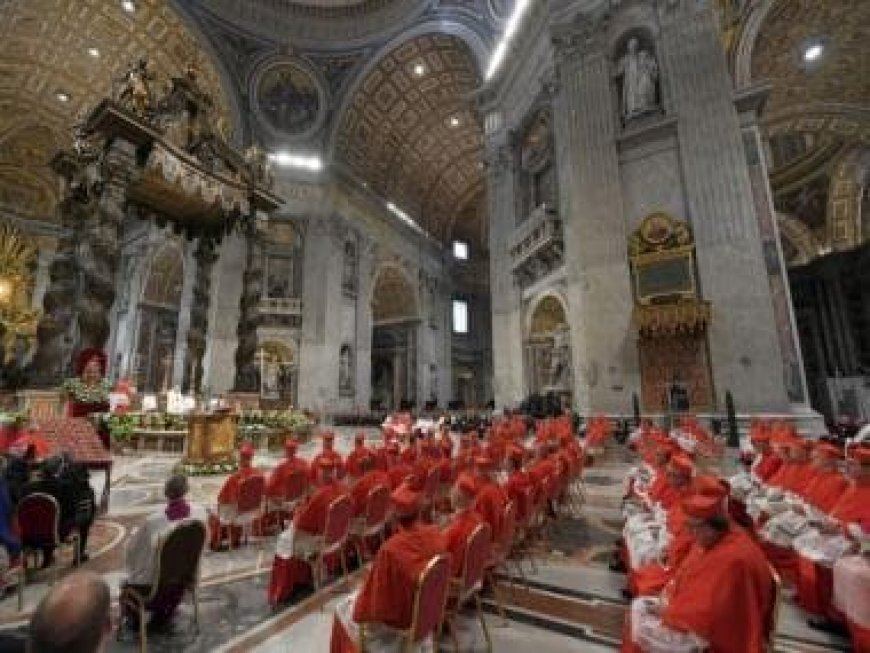All the Pope’s Men: What is the consistory which will see the addition of 21 cardinals?
All the Pope’s Men: What is the consistory which will see the addition of 21 cardinals?

The Catholic Church has been seeing change in recent times and an event today will further decide the future direction of the institution.
Pope Francis on Saturday will elevate 21 clergymen from across the world to the rank of cardinal – also known as the ‘Princes of the Church’ – many of whom will one day cast ballots to elect the Pope’s successor.
The choices include diplomats, close advisers and administrators and one of them could also become the successor to 86-year-old Francis, who has left the door opening to resigning, though he’s not there yet.
So, what exactly is this event called? And why is it important to the Church?
What is the consistory?
The ceremony to be held today (30 September) at 08:00 GMT (1.30 pm IST) in St Peter’s Square is known as a consistory and this will be the ninth such event since Francis was elected pope in 2013.
The consistory is made up of cardinals, the pope’s closest assistants and advisers, from all around the world. A consistory is a formal meeting of the College of Cardinals. The pope can convene them for a number of reasons.
One of the most common reasons for a consistory is to create new cardinals – an ordinary public consistory. Another consistory the Pope could convene is a consistory to vote on the causes of new saints, the last step before a formal canonisation can take place.
There are also extraordinary consistories, in which every cardinal is expected to take part, barring a serious reason.
The last ordinary public consistory took place on 27 August 2022.
Today’s consistory will see the new cardinals kneel before the Pope to receive their two symbols of their high office: a scarlet four-cornered cap known as a biretta, and a cardinal’s ring.
Eighteen of the 21 new cardinals are under the age of 80 and thus currently eligible to vote as “cardinal electors” in the next conclave, when Francis’ successor will be decided.

Who will be part of the consistory?
Pope Francis is looking to the world’s “peripheries” – where Catholicism is growing – for his latest roster of cardinals. He’s breaking tradition of promoting archbishops of large, powerful dioceses.
“He is looking for cardinals who correspond to the times. These are people who have all taken a step away from the Church of the past, who positively ensure a break,” an informed observer of the Holy See told AFP.
“He likes bishops who take action.”
There are three new cardinals from South America, including two Argentinians, and three from Africa, with the promotion of the archbishops of Juba in South Sudan, South Africa’s Cape Town and Tabora in Tanzania.
Asia is represented by the Bishop of Penang in Malaysia and the Bishop of Hong Kong, Stephen Chow, who is seen as playing a key role in seeking to improve tense relations between the Vatican and Beijing.
“Traditionally, (the Church) was focused on Europe or the United States, but now we need to hear from Africa and Asia,” Chow told reporters Thursday.
Some cardinals-to-be, like Chow, have experience in sensitive zones of the world where the Holy See hopes to play an important diplomatic role.

The list includes the Holy Land’s top Catholic authority, Italian Archbishop Pierbattista Pizzaballa, the first serving Latin Patriarch of Jerusalem to be made cardinal.
“Jerusalem is the centre of the world, but it is also the periphery. We know that Pope Francis pays attention to the periphery,” Pizzaballa told AFP.
“Jerusalem is a small laboratory, interreligious and intercultural, and that’s a challenge that the whole world is facing at this point,” he said.
Also to be promoted is the apostolic nuncio, or ambassador, to the United States, France’s Christophe Pierre, whose decades-long diplomatic career includes posts in countries including Haiti, Uganda and Mexico.
Top administrators in the Curia, the government of the Holy See, who are considered close to Francis are also being recognised.
There is Italy’s Claudio Gugerotti, prefect of the Dicastery for the Eastern Churches; Argentina’s Victor Manuel Fernandez, whom the pope recently named head of the powerful Dicastery for the Doctrine of the Faith; and Chicago-born Robert Prevost, a former missionary in Peru who leads the Dicastery for Bishops.
Why this matters?
According to the Vatican, as of 29 September, there were 119 cardinal electors ahead of the consistory and 102 non-electors. After the consistory, the number will rise to 105 non-electors and 136 electors.
Francis has shaped the college greatly during his 10 years as pope, appointing 98, or 72 per cent, of the current electors after the conclave on 30 September. The rest were appointed by St John Paul II and Pope Benedict XVI. In all, he has named cardinals from 66 countries, including several first-time nations, such as South Sudan, Singapore, and Mongolia.
This number assumes significance given the current requirement that a candidate needs a two-thirds majority of the cardinals’ votes to be elected pope.
With inputs from AFP
What's Your Reaction?



























































